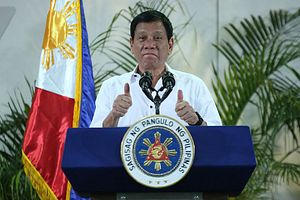On June 17, the Philippine navy held another iteration of celebrations tied to its annual founding anniversary. The engagement once again highlighted the mix of opportunities and challenges that remain for the Philippines’ naval modernization under President Rodrigo Duterte.
As I have noted before in these pages, as Philippine military modernization continues under Duterte, with a mix of continuity and change and amid a range of trends and developments, observers have been looking to get a sense of how the Philippines, which remains one of the weakest militaries in the Asia-Pacific, is looking to further boost its capabilities and address a spectrum of maritime challenges.
This week, the state of Philippine naval modernization was in the headlines again with the commemoration of the Philippine navy’s 121st founding anniversary. While the backdrop to the anniversary celebrations, held in Sangley Point in Cavite, were far from ideal given that the Philippines was still contending from the fallout from a collision by a Chinese ship that left 22 Philippine fishermen at sea, the event, which was attended by top Philippine officials including Duterte himself, was nonetheless notable and closely watched.
While the anniversary itself comprised several components, among them was the focus on new developments in Philippine naval modernization that came from Philippine navy chief Robert Empedrad. In his remarks, Empedrad reiterated that the acquisition of several naval assets was in the pipeline in line with ongoing modernization efforts and priority areas for Manila’s defense policy going forward for the rest of Duterte’s single six-year term.
Some of these were updates with respect to current acquisitions already underway. For instance, Empedrad gave updates on the state of the frigates from South Korea, which have been key for Manila and Philippine-South Korea defense collaboration, announcing that new frigates will be delivered earlier than previously announced dates. The commemoration was also an opportunity to integrate new equipment into the Philippine military, including new anti-submarine warfare helicopters.
Others were newer. For instance, Empedrad made reference to the approval of two corvette warships costing 28 billion pesos (roughly $535.87 million) that were more capable than two new South Korean frigates, which would also be part of Philippine capabilities. He also mentioned other line items, including eight fast attack interdiction craft missile for which a budget of 10 billion pesos had been allocated, shore-based missile systems, and, notably, the acquisition of two submarines which had been in the headlines previously as well.
Unsurprisingly, given the Duterte administration’s priority areas for defense policy, Empedrad focused most of his remarks on domestic issues such as countering terrorism and insurgencies, despite the fact that Manila faces a wide spectrum of threats and new equipment can be used for a range of purposes. For instance, he noted that the addition of missile capabilities would help “easily destroy” the enemy in another Marawi-type war, making reference to the crisis that the Philippines had experienced following a siege by Islamic State-backed rebels in the country’s south. He also framed the delivery of a donated Pohang-class corvette by South Korea, expected soon, in a similar way, noting that total control of maritime waters in Mindanao would help the country fight a decades-old communist insurgency by denying them transportation links and disrupting logistics or supply lines during a future conflict.
That said, Empedrad did not shy away from addressing other aspects of Philippine security policy, even though they highlighted divergences between Duterte’s own public stances. For instance, when addressing the recent China-Philippine collision, for instance, Empedrad said that contrary to initial Chinese claims, this was far from a “normal maritime accident.” This was a much stronger statement compared to Duterte’s remarks where, after days of silence, he had called it a “maritime incident.”
Overall, while nothing wholly new was disclosed, the anniversary celebration did give a sense of the state of play of some ongoing and newer acquisitions for the Philippine navy. As we move into the rest of 2019 and into 2020, it will be interesting to watch the extent of continuity and change with respect to what we have heard from Philippine officials.
































